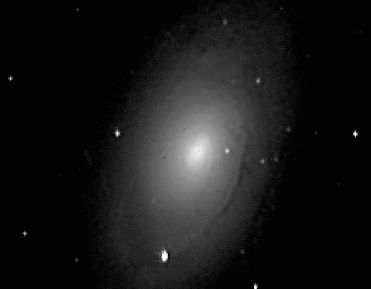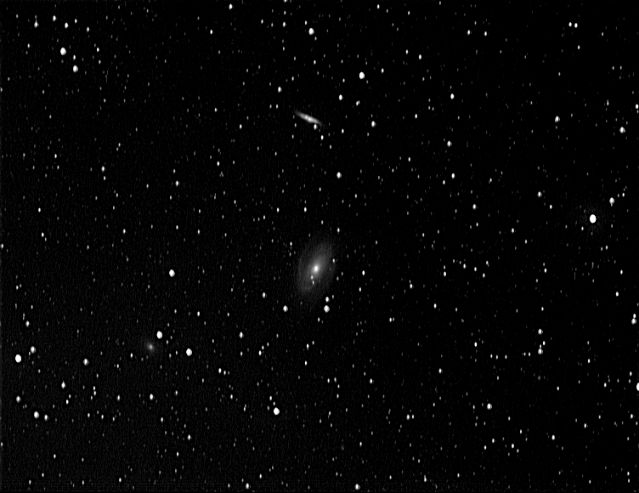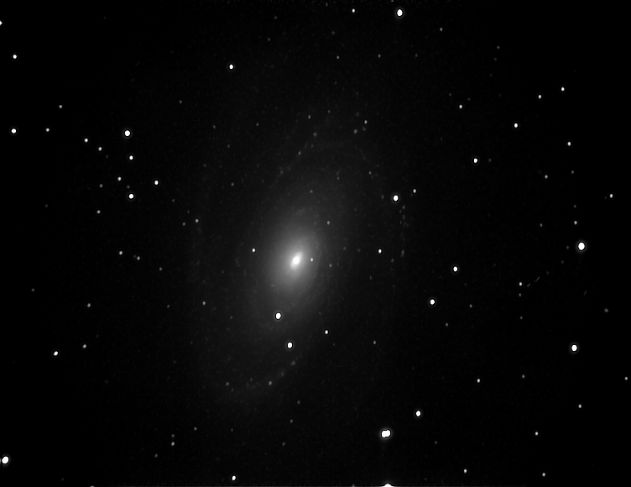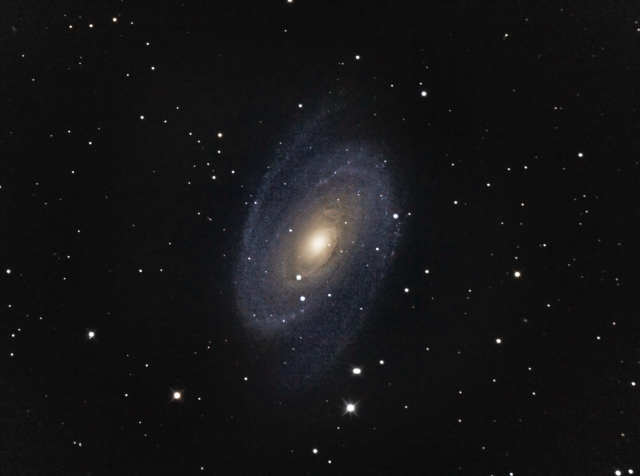

M81 is a spectacular spiral galaxy and the first picture here does not do it justice. It is quite close at 12 million light years, and is quoted as being almost naked-eye visibility, but this applies to the central bulge, the outer parts of the galaxy are quite faint. It was discovered by Johann Bode on 31st December 1774. It was independently rediscovered by Pierre Méchain in 1779 and catalogued by Charles Messier in 1781. It subtends angles of 24.9 and 11.5 arc-minutes which corresponds to a diameter of about 80,000 light years.
The images below are in chronological order and so the best one may be at the bottom.
 |
My first attempt at this galaxy. Although the galaxy as a whole is magnitude 6.9, its surface is quite dim at magnitude 13.2 and I have difficulty distinguishing it from the background light pollution. The capture software for the MX716 camera has some powerful processing functions (see my page on M108) using which I could distinguish the galaxy on the preview screen. I had to apply these functions to each individual frame prior to stacking them in K3CCDTools. Date and Time: 1st April 2009 21:41 to 22:41 UT Camera: MX716 Telescope: LX200 with 0.33 focal reducer. Capture: Starlight Xpress. 10 frames, 120" exposure Pre-processing: Star_mx7_usb, background subtraction, non-linear stretch. Processing: K3CCDTools. 6 frames stacked. Post-processing: PhotoImpact: brightness -10, gamma 1.5, Focus Magic 7,100. |
||
 |
A wide-angle view of the area around M81 which includes two other galaxies M82 and NGC3077. Move your mouse over the image to see them labelled; I have also labelled a few of the brighter stars with the magnitudes of two of them included. The brightest object in the picture is M81 at 6.9 which is just below normal naked-eye visibility, so not one object in this picture is visible to the naked eye. I have a more detailed picture of M82 here. The separation of M81 and M82 is 37 minutes of arc, which corresponds to a distance of 100,000 light years at their distance of 10 million light years. NGC3077 is also a member of the M81 group; it is 46 arc minutes away from M81 corresponding to about 124,000 light years. Both these galaxies show signs of being disrupted by close passage of their large neighbour, M81, sometime in the past. Date and Time: 5th February 2010 21:59 to 22:40 UT Camera: MX716 Telescope: 135mm SLR lens at f/4 with Orion Skyglow and IR-blocking filters. Capture: Starlight Xpress. 39 frames, 60" exposure Pre-processing: Star_mx7_usb, background subtraction, non-linear stretch factor 25. Processing: RegiStax5. 33 frames stacked, gamma 2.0, histogram 30-255, wavelets 1-2=5. |
||
 |
A better view of M81 which, despite the lower exposure compared to the first picture here, shows more extensive spiral arms. Date and Time: 7th October 2011 20:21 to 20:33 UT Camera: MX716 Telescope: LX200 with 0.33 focal reducer and Astronomik CLS filter. Capture: Starlight Xpress. 10 frames, 60" exposure Pre-processing: Star_mx7_usb, background subtraction, non-linear stretch factor 25. Processing: RegiStax6. 10 frames stacked, Gaussian wavelets Scheme 3. Focus Magic 2,100. |
||
 |
I have been impressed by the pictures taken by others using DSLR cameras. And I have realised that combined with my Ritchey-Chrétien telescope I can get high-resolution images of areas of the sky about the size of the Full Moon. This picture was obtained with this combintion. However I feel I can take very little credit for this picture. I collected the data but had no success whatever finding a good image in it. I am grateful to Rachael Wood, a friend from the Doncaster Astronomical Society, for applying her skills with PhotoShop to recover this picture for me. I give no details below because I have no idea how she did it.... Date and Time: 13th May 2020 22:05 to 22:55 UT Camera: Canon 1100D Telescope: 8-inch Ritchey-Chrétien Capture: Canon EOS. 25 Raw format (.cr2) frames, ISO 800, 120" exposure (lights and darks), Flats and Bias as appropriate. Processing: Deep Sky Stacker Post-processing: PhotoShop by Rachael Wood. |
||
Home Back to DSOs